Key takeaways:
- Feedback is essential for growth and should be viewed as a valuable perspective, not just criticism.
- Different types of feedback, including audience reactions and peer reviews, play a crucial role in improving speaking skills.
- Implementing feedback effectively can lead to significant improvements in presentation style and audience engagement.
- Continuous improvement is fostered through creating an open dialogue and integrating audience suggestions into future presentations.
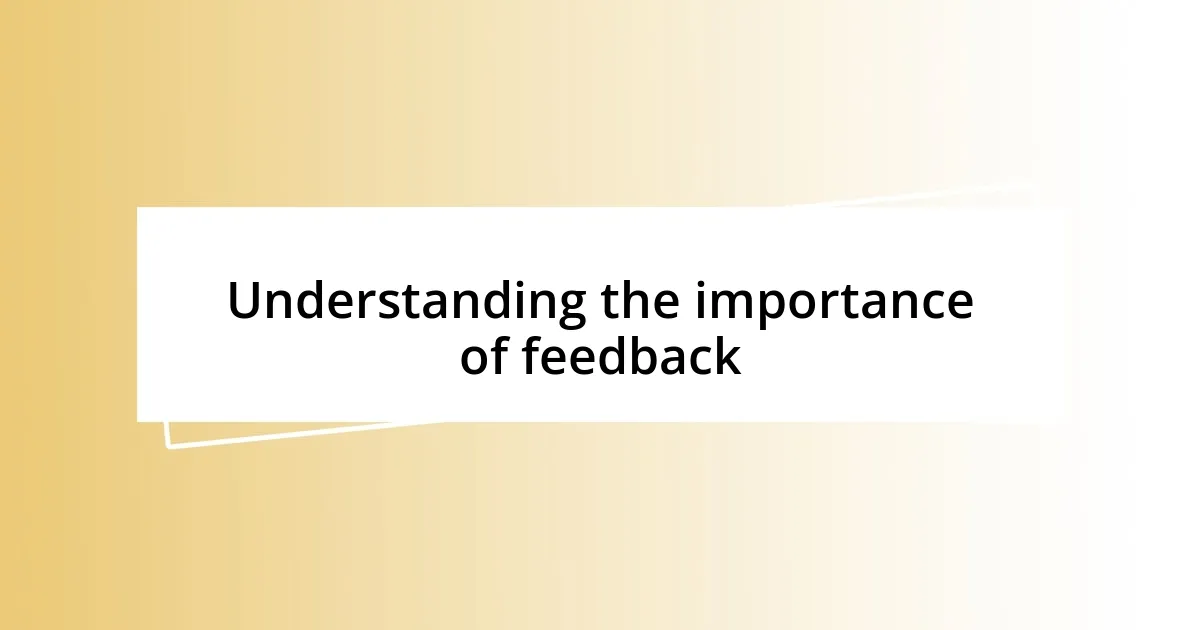
Understanding the importance of feedback
Feedback is an essential tool for growth and improvement, but its significance often goes unrecognized. Reflecting on my early speaking experiences, I remember receiving feedback that felt tough to digest. Yet, upon reconsideration, I realized it wasn’t criticism but rather a vital perspective I needed to improve.
One time, after delivering a presentation, a fellow speaker candidly pointed out how my energy fluctuated throughout the talk. At first, it stung a bit, but it made me ponder: How can I expect to engage my audience if my own enthusiasm wanes? This moment of clarity helped me appreciate that feedback isn’t just information; it’s a mirror reflecting how others perceive my efforts.
I’ve found that embracing feedback can be uncomfortable, but imagine how naive it would be to navigate this journey without it. Envision standing alone on a stage, thinking you’re delivering the performance of a lifetime, only to learn later that the audience felt disconnected. That discomfort might actually be the catalyst for meaningful progress, urging us to step outside our comfort zones and seek improvement.
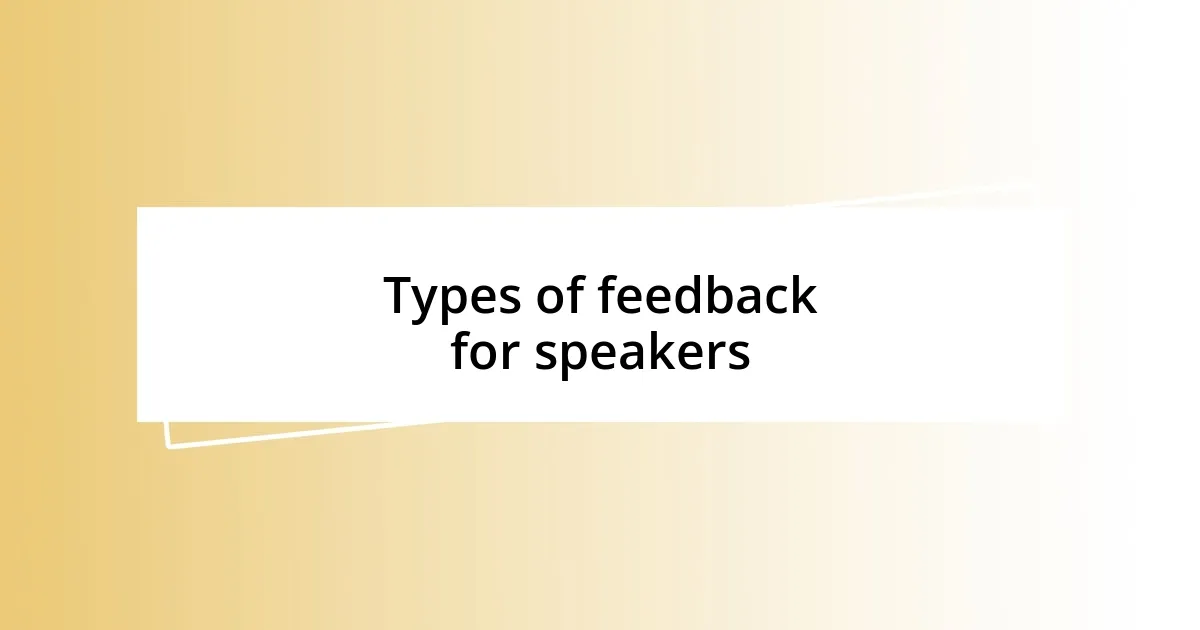
Types of feedback for speakers
Feedback for speakers can take several forms, each valuable for different aspects of performance. Personally, I’ve learned to appreciate both positive and constructive feedback. Positive feedback boosts confidence and reinforces what works well, while constructive criticism highlights areas needing improvement—each playing a critical role in an evolving speaking journey.
Here’s a breakdown of the types of feedback I often encounter:
- Audience Reactions: Observing facial expressions and body language can provide immediate insights into how your message is being received.
- Peer Reviews: Fellow speakers often offer insights based on their own experiences, providing a relatable perspective that can resonate deeply.
- Recorded Evaluations: Watching recordings of my presentations has always been revealing—I find habits and quirks I wasn’t aware of, helping me refine my delivery.
- Self-reflection: I jot down my thoughts post-presentation, analyzing my feelings and what went well or could be improved.
Embracing these varied feedback types has profoundly impacted my growth, showing me that every piece of feedback is a stepping stone toward becoming a more effective communicator.
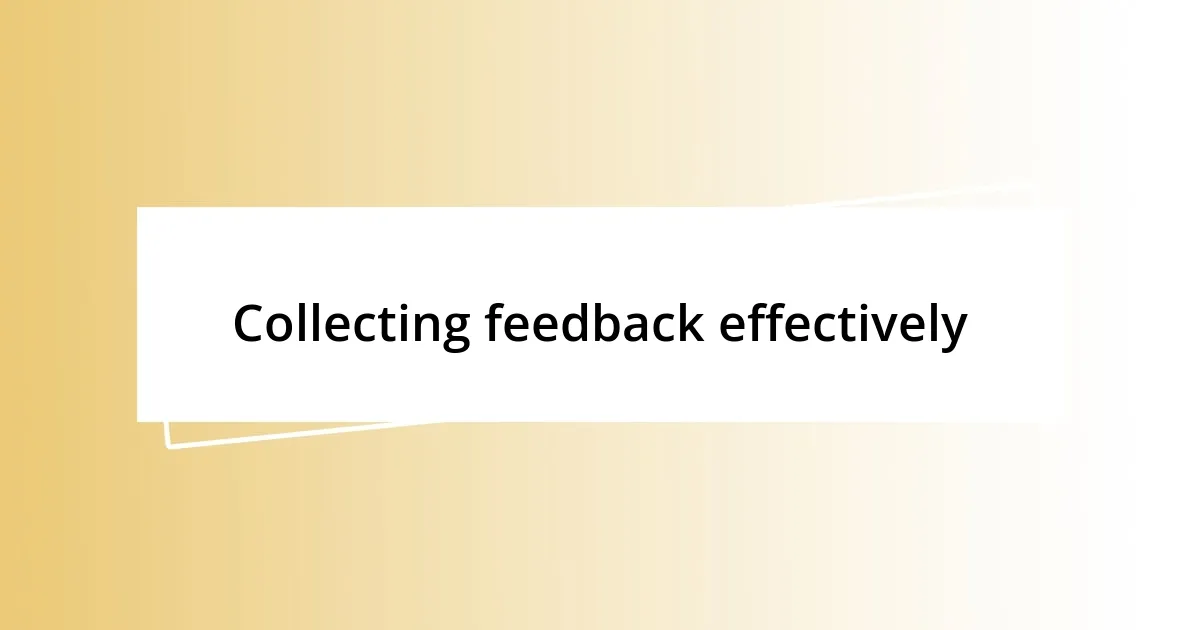
Collecting feedback effectively
Collecting feedback effectively requires a strategic approach that encourages openness and sincerity from both the speaker and the audience. One method I’ve found particularly useful is to create a safe space for honest dialogue. For example, I once held a feedback session where I explicitly asked my audience to share their thoughts without hesitation. The results were illuminating. Many participants expressed concerns they might have otherwise held back, and I was able to address these points directly, fostering a richer discussion.
Timing is also crucial. I’ve noticed that asking for feedback shortly after a presentation can lead to more genuine responses. People’s impressions are freshest, and they’re often still engaged with the experience. In a recent workshop, I employed a quick digital survey right after my talk. The feedback flooded in, and it helped me instantly identify both strengths and areas for enhancement.
Ultimately, blending various collection methods—like informal conversations, digital surveys, or structured feedback forms—can offer a comprehensive view of performance. Reflecting on how I utilized an anonymous feedback form after a particularly challenging presentation, I was surprised to see how many audience members appreciated my vulnerability in tackling difficult topics. It showed me that regardless of my discomfort, being transparent can foster a connection with the audience that might be overlooked otherwise.
| Feedback Method | Pros |
|---|---|
| Immediate Peer Feedback | Encourages candid discussions, offering direct insights. |
| Anonymous Surveys | Promotes honesty without fear of judgment, revealing deeper sentiments. |
| Recorded Evaluations | Allows for self-reflection, pinpointing areas for improvement based on personal review. |
| Informal Conversations | Facilitates a more personal connection, encouraging organic feedback exchange. |
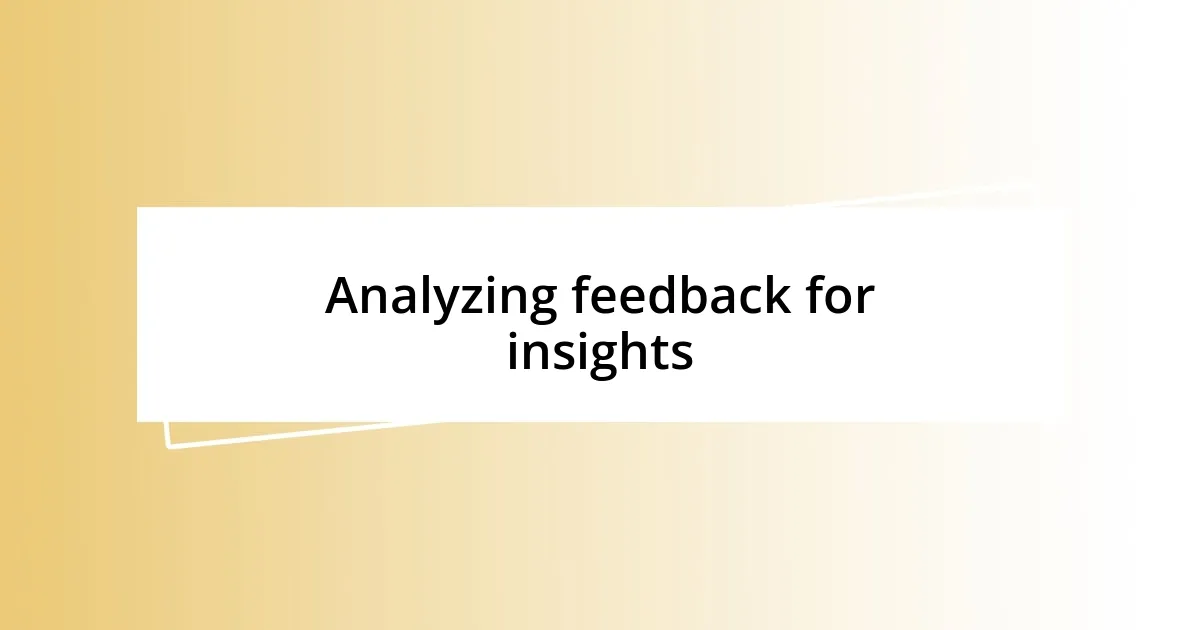
Analyzing feedback for insights
Analyzing feedback to glean insights is a pivotal step in my growth as a speaker. I often find that when I comb through audience reactions, I can uncover underlying themes or trends. For instance, during one particularly lively presentation, several audience members mentioned a specific story that resonated with them. That feedback made me realize the power of personal anecdotes in connecting with my audience, encouraging me to weave more of these stories into my talks.
It’s fascinating how feedback can illuminate areas for development that I might not have noticed on my own. After assessing a recording of a recent workshop, I was shocked to see just how many filler words I used. This realization stung a bit, but it motivated me to practice my delivery with much more intent. How many times have we delivered a message, only to find out later that our execution didn’t match our intent? I think it’s an experience many of us have faced.
Moreover, I’ve learned to appreciate the emotional tone within written feedback. Sometimes, just a few words can convey a profound sentiment. I remember receiving a comment that said, “Your passion is contagious!” That little note brightened my day and reminded me to always lead with enthusiasm. Engaging with feedback in a deeper manner helps me transform insights into actionable steps for improvement, ensuring each subsequent presentation is even better than the last.
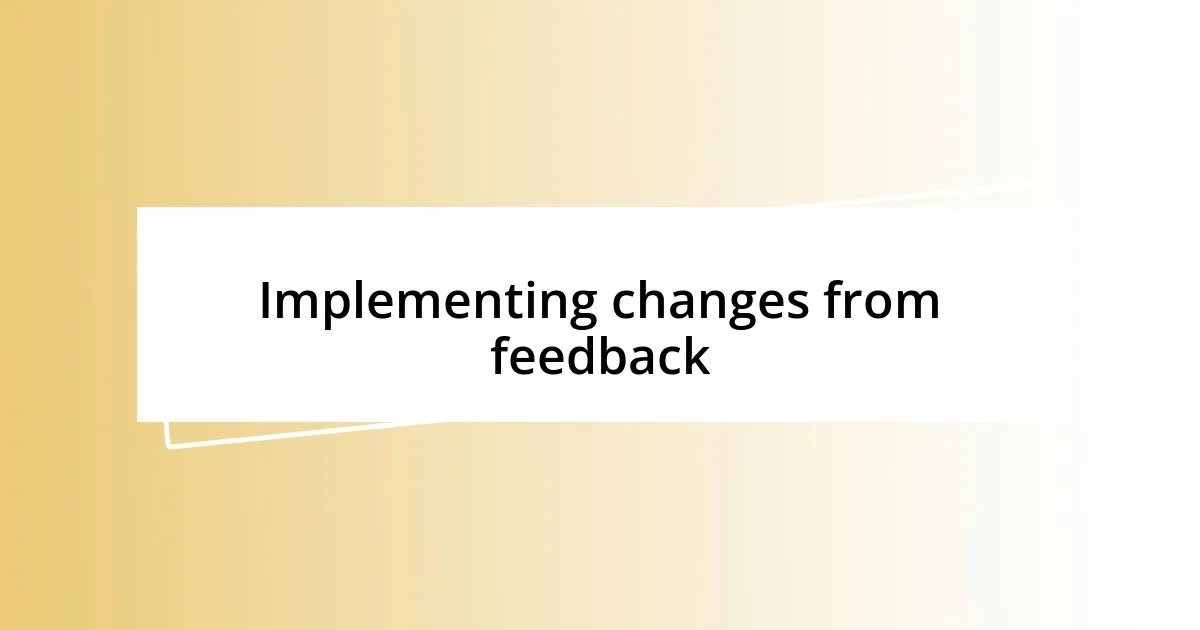
Implementing changes from feedback
Implementing changes from feedback requires a proactive mindset. After receiving constructive criticism regarding my pacing during presentations, I made a conscious effort to work on this aspect. In my next talk, I slowed down my delivery significantly, which I felt transformed the audience’s engagement. It was rewarding to see their reactions shift as I became more deliberate in my speech.
Another time, an audience member pointed out that I could better clarify complex concepts I presented. Taking this to heart, I introduced analogies that resonated with everyday experiences. When I tested this approach in my following seminars, the audience feedback was overwhelmingly positive. It’s moments like these that highlight the importance of not just hearing, but truly listening to feedback.
There was also a situation where I realized I had been using a lot of jargon in my talks. A friend who attended one of my presentations candidly told me, “I had trouble following you at times.” That comment stuck with me. I knew I needed to refine my language to make it more accessible. So, I began consciously simplifying my terminology, and it made a world of difference—not just in terms of understanding, but in building a stronger connection with my audience. Isn’t it amazing how a small change in approach can lead to greater clarity and impact?
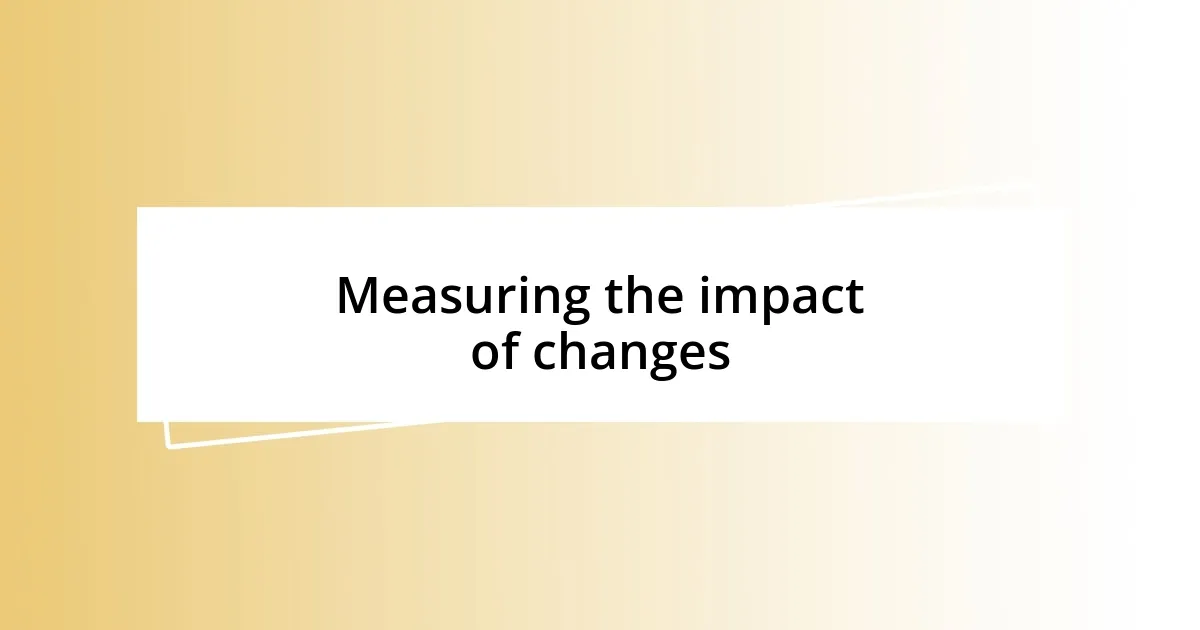
Measuring the impact of changes
Measuring the impact of changes is about more than just gathering audience feedback—it’s about truly reflecting on how those shifts affect engagement. After tweaking my presentation style to slow down a bit, I took extra care to observe body language and facial expressions in the audience. I was pleasantly surprised to see more heads nodding and open postures in the room. Such signals felt like immediate indicators of my improvement—a feedback loop that validated my efforts to refine my delivery.
One time, I adjusted my visuals based on past critiques to make them clearer and more inviting. After the presentation, I sought out specific responses regarding those changes, and the excitement from the audience was palpable. “I could really focus on what you were saying rather than straining to read the slides!” one attendee exclaimed. That moment struck a chord with me; it reinforced how essential the visual elements are in supporting my verbal message. Feeling that level of engagement made me want to keep pushing for improvement.
I find that tracking this kind of feedback over multiple presentations can reveal even deeper patterns, almost like creating a personal report card for my speaking skills. I once compiled audience ratings and comments over a series of talks to assess my growth trajectory. The trends showed a direct correlation between the adjustments I made and the improvements in my overall ratings. Isn’t it fascinating how quantifiable feedback can provide a clearer picture of our progress? This ongoing process not only boosts my confidence but also inspires continuous development in my speaking journey.
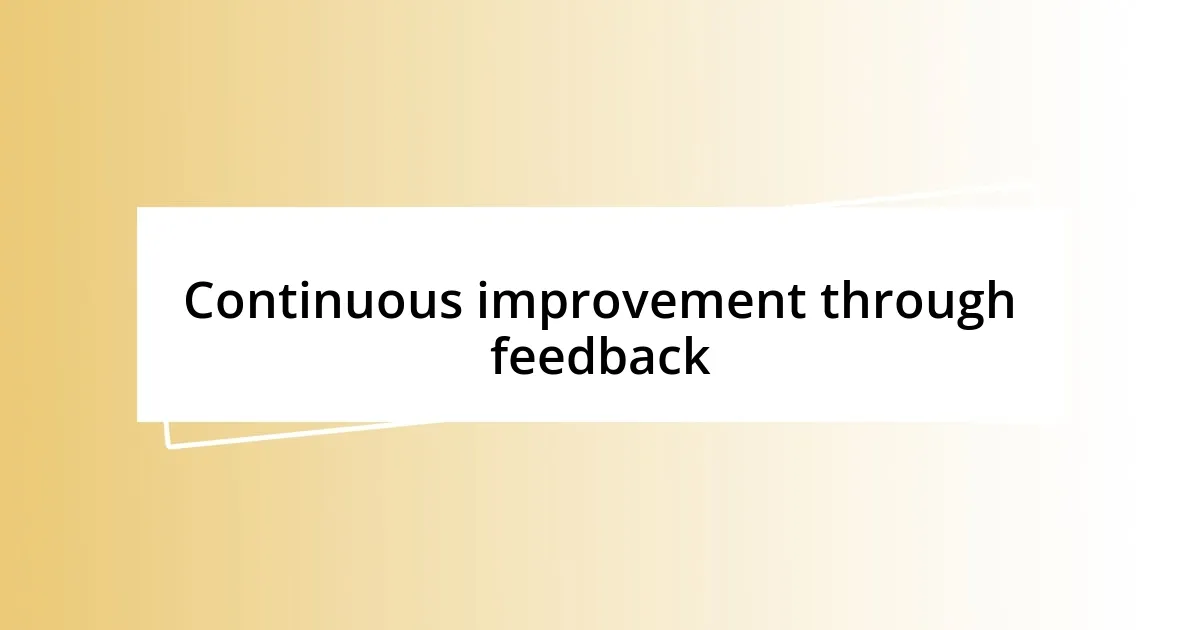
Continuous improvement through feedback
Continuous improvement thrives on the foundation of feedback. I remember a time when I received feedback about my use of pauses during my talks. Initially, I was hesitant to embrace this suggestion because I thought silence could disrupt the flow. However, after giving it a try, I discovered that allowing moments of silence gave my audience time to absorb important points. It felt transformative when I realized that these pauses enhanced the overall impact of my message. Isn’t it interesting how a simple adjustment can elevate communication?
Engaging with feedback means creating a safe space for open dialogue. Once, during a small workshop, a participant candidly expressed that my examples felt outdated. I appreciated their honesty and, rather than defensively dismissing the comment, I took it as a valuable prompt. That feedback pushed me to incorporate fresh, relevant examples drawn from recent trends. The energy in the room shifted noticeably when I introduced these new anecdotes—it felt more relatable and alive. How rewarding is it to see the audience’s eyes light up with understanding?
Lastly, I find that integrating feedback is about being vulnerable and willing to grow. One of my mentors once challenged me to ask my audience for direct feedback during the session. Initially, I was nervous about what they might say. But when I embraced that openness, I received enlightening insights that I would have otherwise missed. For instance, attendees pointed out that more interaction would enhance their experience. Implementing more interactive elements transformed my presentations into lively discussions, fostering connections that felt much deeper. Isn’t that what we all strive for—to create an engaging and lasting impact?












